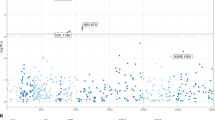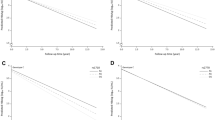Abstract
Clearance of acute infection with hepatitis C virus (HCV) is associated with the chr19q13.13 region containing the rs368234815 (TT/ΔG) polymorphism. We fine-mapped this region to detect possible causal variants that may contribute to HCV clearance. First, we performed sequencing of IFNL1-IFNL4 region in 64 individuals sampled according to rs368234815 genotype: TT/clearance (N = 16) and ΔG/persistent (N = 15) (genotype-outcome concordant) or TT/persistent (N = 19) and ΔG/clearance (N = 14) (discordant). 25 SNPs had a difference in counts of alternative allele >5 between clearance and persistence individuals. Then, we evaluated those markers in an association analysis of HCV clearance conditioning on rs368234815 in two groups of European (692 clearance/1 025 persistence) and African ancestry (320 clearance/1 515 persistence) individuals. 10/25 variants were associated (P < 0.05) in the conditioned analysis leaded by rs4803221 (P value = 4.9 × 10−04) and rs8099917 (P value = 5.5 × 10−04). In the European ancestry group, individuals with the haplotype rs368234815ΔG/rs4803221C were 1.7× more likely to clear than those with the rs368234815ΔG/rs4803221G haplotype (P value = 3.6 × 10−05). For another nearby SNP, the haplotype of rs368234815ΔG/rs8099917T was associated with HCV clearance compared to rs368234815ΔG/rs8099917G (OR: 1.6, P value = 1.8 × 10−04). We identified four possible causal variants: rs368234815, rs12982533, rs10612351 and rs4803221. Our results suggest a main signal of association represented by rs368234815, with contributions from rs4803221, and/or nearby SNPs including rs8099917.
This is a preview of subscription content, access via your institution
Access options
Subscribe to this journal
Receive 6 digital issues and online access to articles
$119.00 per year
only $19.83 per issue
Buy this article
- Purchase on Springer Link
- Instant access to full article PDF
Prices may be subject to local taxes which are calculated during checkout




Similar content being viewed by others
Change history
12 November 2020
The original version of this Article contained an error in the author name for Thomas R. O’Brien. The family name contained a space and incorrectly appeared as O’ Brien. This has now been corrected in both the PDF and HTML versions of the Article.
23 November 2020
A Correction to this paper has been published: https://doi.org/10.1038/s41435-020-00119-z
References
Rauch A, Kutalik Z, Descombes P, Cai T, Di Iulio J, Mueller T, et al. Genetic variation in IL28B is associated with chronic hepatitis C and treatment failure: a genome-wide association study. Gastroenterology. 2010;138:1338–45. 1345.e1–7
Duggal P, Thio CL, Wojcik GL, Goedert JJ, Mangia A, Latanich R, et al. Genome-wide association study of spontaneous resolution of hepatitis C virus infection: data from multiple cohorts. Ann Intern Med. 2013;158:235–45.
Vergara C, Thio CL, Johnson E, Kral AH, O’Brien TR, Goedert JJ, Multi-Ancestry Genome-Wide Association Study of Spontaneous Clearance of Hepatitis C Virus. Gastroenterology. 2019;156:1496–507.
Prokunina-Olsson L, Muchmore B, Tang W, Pfeiffer RM, Park H, Dickensheets H, et al. A variant upstream of IFNL3 (IL28B) creating a new interferon gene IFNL4 is associated with impaired clearance of hepatitis C virus. Nat Genet. 2013;45:164–71.
Hong M, Schwerk J, Lim C, Kell A, Jarret A, Pangallo J, et al. Interferon lambda 4 expression is suppressed by the host during viral infection. J Exp Med. 2016;213:2539–52.
Thomas DL, Thio CL, Martin MP, Qi Y, Ge D, O’Huigin C, et al. Genetic variation in IL28B and spontaneous clearance of hepatitis C virus. Nature. 2009;461:798–801.
Tillmann HL, Thompson AJ, Patel K, Wiese M, Tenckhoff H, Nischalke HD, et al. A polymorphism near IL28B is associated with spontaneous clearance of acute hepatitis C virus and jaundice. Gastroenterology. 2010;139:1586–92. 1592.e1
Knapp S, Warshow U, Ho KM, Hegazy D, Little AM, Fowell A, et al. A polymorphism in IL28B distinguishes exposed, uninfected individuals from spontaneous resolvers of HCV infection. Gastroenterology. 2011;141:320–5. 325.e1-2
Aka PV, Kuniholm MH, Pfeiffer RM, Wang AS, Tang W, Chen S, et al. Association of the IFNL4-ΔG allele with impaired spontaneous clearance of hepatitis C virus. J Infect Dis. 2014;209:350–4.
Chinnaswamy S. Genetic variants at the IFNL3 locus and their association with hepatitis C virus infections reveal novel insights into host-virus interactions. J Interferon Cytokine Res. 2014;34:479–97.
Spain SL, Barrett JC. Strategies for fine-mapping complex traits. Hum Mol Genet. 2015;24:R111–9.
Mandelker D, Schmidt RJ, Ankala A, McDonald Gibson K, Bowser M, Sharma H, et al. Navigating highly homologous genes in a molecular diagnostic setting: a resource for clinical next-generation sequencing. Genet Med. 2016;18:1282–9.
Smith KR, Suppiah V, O’Connor K, Berg T, Weltman M, Abate ML, et al. Identification of improved IL28B SNPs and haplotypes for prediction of drug response in treatment of hepatitis C using massively parallel sequencing in a cross-sectional European cohort. Genome Med. 2011;3:57.
Sudmant PH, Rausch T, Gardner EJ, Handsaker RE, Abyzov A, Huddleston J, et al. An integrated map of structural variation in 2504 human genomes. Nature. 2015;526:75–81.
Kotenko SV, Gallagher G, Baurin VV, Lewis-Antes A, Shen M, Shah NK, et al. IFN-lambdas mediate antiviral protection through a distinct class II cytokine receptor complex. Nat Immunol. 2003;4:69–77.
Sheppard P, Kindsvogel W, Xu W, Henderson K, Schlutsmeyer S, Whitmore TE, et al. IL-28, IL-29 and their class II cytokine receptor IL-28R. Nat Immunol. 2003;4:63–8.
O’Brien TR, Prokunina-Olsson L, Donnelly RP. IFN-lambda4: the paradoxical new member of the interferon lambda family. J Interferon Cytokine Res. 2014;34:829–38.
Wojcik GL, Thio CL, Kao WH, Latanich R, Goedert JJ, Mehta SH, et al. Admixture analysis of spontaneous hepatitis C virus clearance in individuals of African descent. Genes Immun. 2014;15:241–6.
Li Y, Willer C, Sanna S, Abecasis G. Genotype imputation. Annu Rev Genomics Hum Genet. 2009;10:387–406.
Willer CJ, Li Y, Abecasis GR. METAL: fast and efficient meta-analysis of genomewide association scans. Bioinformatics. 2010;26:2190–1.
Schaid DJ, Chen W, Larson NB. From genome-wide associations to candidate causal variants by statistical fine-mapping. Nat Rev Genet. 2018;19:491–504.
Gabriel SB, Schaffner SF, Nguyen H, Moore JM, Roy J, Blumenstiel B, et al. The structure of haplotype blocks in the human genome. Science. 2002;296:2225–9.
Barrett JC, Fry B, Maller J, Daly MJ. Haploview: analysis and visualization of LD and haplotype maps. Bioinformatics. 2005;21:263–5.
Schaid DJ, Rowland CM, Tines DE, Jacobson RM, Poland GA. Score tests for association between traits and haplotypes when linkage phase is ambiguous. Am J Hum Genet. 2002;70:425–34.
Kichaev G, Pasaniuc B. Leveraging functional-annotation data in trans-ethnic fine-mapping studies. Am J Hum Genet. 2015;97:260–71.
Kichaev G, Yang WY, Lindstrom S, Hormozdiari F, Eskin E, Price AL, et al. Integrating functional data to prioritize causal variants in statistical fine-mapping studies. PLoS Genet. 2014;10:e1004722.
Purcell S, Cherny SS, Sham PC. Genetic Power Calculator: design of linkage and association genetic mapping studies of complex traits. Bioinformatics. 2003;19:149–50.
Origa R, Marceddu G, Danjou F, Perseu L, Satta S, Demartis FR, et al. IFNL3 polymorphisms and HCV infection in patients with beta thalassemia. Ann Hepatol. 2015;14:389–95.
Suppiah V, Moldovan M, Ahlenstiel G, Berg T, Weltman M, Abate ML, et al. IL28B is associated with response to chronic hepatitis C interferon-alpha and ribavirin therapy. Nat Genet. 2009;41:1100–4.
Tanaka Y, Nishida N, Sugiyama M, Kurosaki M, Matsuura K, Sakamoto N, et al. Genome-wide association of IL28B with response to pegylated interferon-alpha and ribavirin therapy for chronic hepatitis C. Nat Genet. 2009;41:1105–9.
Fernandez-Rodriguez A, Rallon N, Berenguer J, Jimenez-Sousa MA, Cosin J, Guzman-Fulgencio M, et al. Analysis of IL28B alleles with virologic response patterns and plasma cytokine levels in HIV/HCV-coinfected patients. AIDS. 2013;27:163–73.
Booth DR, Ahlenstiel G, George J. Pharmacogenomics of hepatitis C infections: personalizing therapy. Genome Med. 2012;4:99.
Terczynska-Dyla E, Bibert S, Duong FH, Krol I, Jorgensen S, Collinet E, et al. Reduced IFNlambda4 activity is associated with improved HCV clearance and reduced expression of interferon-stimulated genes. Nat Commun. 2014;5:5699.
O’Brien TR, Pfeiffer RM, Paquin A, Lang Kuhs KA, Chen S, Bonkovsky HL, et al. Comparison of functional variants in IFNL4 and λL3 for association with HCV clearance. J Hepatol. 2015;63:1103–10.
Acknowledgements
We thank the participants of the study. We also thank Cristian Velarde for the graphic design of the figures.
Funding
R01-013324, 2R01-AI148049, DA-04334, U19-AI088791, HHSN261200800001E, U01-AI35042, U01-AI35043, U01-AI35039, U01-AI35040, U01-AI35041, U01-AI35004, U01-AI31834, U01-AI34994, U01-AI34989, U01-AI34993, U01-AI42590, U01-HD32632, R01-HL076902, R01-HD-41224, R01-AI148049-21, R21AI139012, U19-AI082630, U01-AI131314, R01-DA033541, U19-AI066345, DA12568, DA036297, R01-DA09532, R01-DA11860, N02CP91027, H79TI12103, R01-DA16159, R01-DA21550, UL1 RR024996.
Author information
Authors and Affiliations
Corresponding author
Ethics declarations
Conflict of interest
The authors declare that they have no conflict of interest.
Additional information
Publisher’s note Springer Nature remains neutral with regard to jurisdictional claims in published maps and institutional affiliations.
Supplementary information
Rights and permissions
About this article
Cite this article
Vergara, C., Duggal, P., Thio, C.L. et al. Multi-ancestry fine mapping of interferon lambda and the outcome of acute hepatitis C virus infection. Genes Immun 21, 348–359 (2020). https://doi.org/10.1038/s41435-020-00115-3
Received:
Revised:
Accepted:
Published:
Issue Date:
DOI: https://doi.org/10.1038/s41435-020-00115-3
This article is cited by
-
The role of IFNL4 in liver inflammation and progression of fibrosis
Genes & Immunity (2022)
-
Polymorphism rs368234815 of interferon lambda 4 gene and spontaneous clearance of hepatitis C virus in haemodialysis patients: a case-control study
BMC Infectious Diseases (2021)



